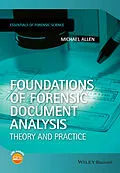Forensic document examination is a long established specialty and its practitioners have regularly been shown to have acquired skills that enable them to assist the judicial process. This book, aimed primarily at students studying forensic science and document examination in particular, introduces all of the essential ideas that are to be found in the work of the forensic document examiner in a concise and straightforward way. Each examination type is described not only in terms of its procedural basis but also the science and reasoning that underpins it. The reader will be able to relate the different kinds of interpretation skills used by the document examiner to those used in other forensic disciplines. This book will be an invaluable text for all students taking courses in Forensic Science or related subjects. The book will also be a useful reference for researchers new to this field or practitioners looking for an accessible overview. The author will be adding new references that are relevant as they are published and some more worked examples from time to time. Please visit qdbook.blogspot.co.uk for more details.
Autorentext
Mike Allen's career in forensic document examination spans thirty years during which time he reported on thousands of cases at all levels of the judicial system and gave evidence in court on numerous occasions. He has been involved in assessing the work of other document examiners, training new examiners and teaching in the universities for the last fifteen years or so. In recent years he has worked with other experts to establish methods of assessing professional competence in a variety of forensic disciplines.
Inhalt
About the Author xi
Series Foreword xiii
Preface xv
Acknowledgements xix
About the Companion Website xxi
1 Introduction 1
1.1 Historical background 1
1.2 Is document examination a science at all? 2
1.3 Quality assurance 6
1.4 Standards in forensic document examination 8
1.5 Competence of forensic practitioners 10
1.6 Cognitive bias 11
1.7 Training to be a forensic document examiner 12
References 13
2 Handwriting Development and Comparison 15
2.1 Introduction 15
2.2 The process of writing 15
2.3 Models of writing production 18
2.4 The learning of handwriting in young children 23
2.5 Handwriting in the adolescent: the origins of individuality 27
2.6 Mature handwriting of the adult 28
2.7 The deterioration of handwriting skill 29
2.8 The forensic analysis of handwriting 32
2.8.1 Specimen handwriting 33
2.8.2 Writing implements 35
2.8.3 Pre-examination review 37
2.8.4 The natural variation of handwriting 38
2.9 Interpretation of handwriting evidence 42
2.9.1 Limitations to the evidence in handwriting cases 42
2.9.2 Reaching conclusions 44
2.9.3 Computer use in interpretation 45
2.10 Examination notes in handwriting cases 47
2.11 Reporting findings 49
Handwriting comparison: a worked example 50
Report of Forensic Expert 56
References 57
3 Signature Examination 63
3.1 Introduction 63
3.2 The development of signatures 65
3.2.1 External influences: alcohol, infirmity and old age 66
3.2.2 Guided hand signatures 67
3.2.3 Signatures in blind people 67
3.3 Simulating signatures 68
3.4 Computer-based recognition of signatures 71
3.5 The forensic examination of signatures 76
3.6 Interpreting findings in signature cases 77
3.7 Note taking in signature cases 81
3.8 Reports in signature cases 81
Signature comparison: a worked example 82
Report of Forensic Expert 86
References 87
4 Documents Produced Using Office Technology 89
4.1 Introduction 89
4.2 Typewriters 90
4.3 The forensic examination of typebar typewriters 96
4.4 Single element typewriters 99
4.5 Typewriter ribbons and correcting typescript 102
4.5.1 Correcting typed documents 103
4.6 Computer printers 105
4.6.1 Impact matrix printers 105
4.6.2 Laser printers 106
4.6.3 The forensic examination of laser printers and laser printed documents 108
4.6.4 Inkjet printers 109
4.6.5 The forensic examination of inkjet printers 110
4.7 Fax (facsimile) machines 111
4.8 Photocopiers 112
4.8.1 The forensic examination of copy documents 113
4.8.2 Composite documents 114
4.8.3 Analysis of toner 114
4.9 Case notes in cases involving typed and copied documents 115
4.10 Reports in cases involving typed and copied documents 117
Typescript comparison: a worked example 118
Report of Forensic Expert 121
References 122
5 The Examination of Printed Documents 123
5.1 Introduction 123
5.2 Some general principles of printing 124
5.2.1 Ink properties 124
5.2.2 Colour management 125
5.2.3 Registration 125
5.2.4 Half tone printing 125
5.2.5 Traditional photographic and modern computer-based processes 127
5.3 Relief printing processes 128
5.3.1 Letterpress 128
5.3.2 Stamp impressions 129
5.4 Planographic printing 131
5.5 Recess printing 132
5.6 Screen printing 133
5.7 Security documents 133
5.7.1 Personalisation of documents 136
